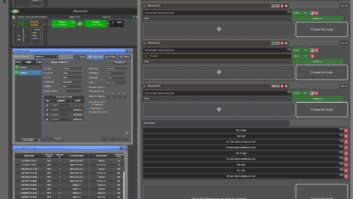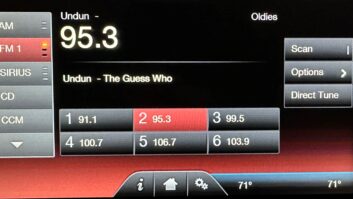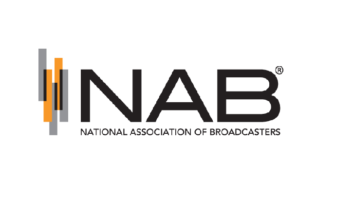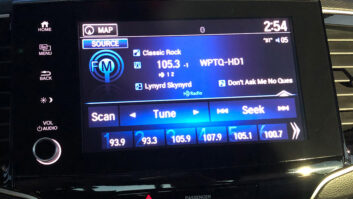

Fig. 1: There’s a new use for these old satellite dishes. Fig. 2: First, remove the feed horn and electronics assembly. If you do any kind of live sports event coverage, check out this project from Newman-Kees’ Frank Hertel. It doesn’t cost much, doesn’t take a lot of time (less than an hour) and results in a parabolic microphone that will give your sports remotes some outstanding field or court noise.
First you need to locate the scrap dish, such as the one pictured in Fig. 1. Along with the dish, you’ll need some pieces of 1/2-inch copper pipe and a couple of 1/2-inch fittings.
Comments accompany each picture here but you can also use your imagination. As presented, the parabolic microphone works well; however, you may think of a way to improve it. A deeper dish will offer a more directional pickup pattern, but almost any dish will work. For this project, Frank used an omnidirectional microphone. A directional or cardioid mic may or may not be an improvement. Try it and see.
So with the dish cleaned and in hand, let’s begin. The first step, shown in Fig. 2, is to remove the dish feed horn assembly and electronics module. Save the circular support ring, seen in Fig. 3, as it will be used as a template for fabricating a filler plate for the hole where the feed horn assembly was mounted.
Using a piece of scrap aluminum, trace the support ring and cut it out, as show in Fig. 4. In Fig. 5, you can see how the rough-cut filler is sanded to provide the finished hole-cover.
Bolt the filler into place, using four #6×32 bolts, washers and nuts, shown in Fig. 6.


Fig. 3: Save the metal support ring. Fig. 4: Use the ring to trace a filler panel carefully. At this point, the work to manufacture the microphone support begins. As seen in Fig. 7, cut a 1-1/4 inch piece of half inch copper pipe. Securing the copper tube in a vise, serrate one end down to the depth of the hack saw blade.
Next, shove the serrated end into a mic adaptor, as shown in Fig. 8. This will initially shape it to size. After removing the copper tube from the mic adaptor, it will look like the piece pictured in Fig. 9.
Fig. 10 demonstrates how to slightly bend the serrated ends, which will secure the microphone adaptor.
And now, to assemble. Frank found that for this size dish, the piece of copper pipe is about 9 inches long. This shallow dish has a broad focus. As seen in Fig. 11, mount a 90-degree sweat (ear) mount to the dish. Insert the 9-inch copper tube and connect a 45-degree sweat elbow to the other end of the tube. To the other end of the 45-degree coupling, insert the mic adaptor you just modified.
Fig. 12 shows the finished product, with the mic adaptor added and the microphone in position for testing.
Though you would think that the copper joints could be soldered, Frank suggests securing them with #6×3/8 self-tapping screws. This will provide for easy assembly or reassembly, making physical changes for different microphones possible. Although the serrated mic holder adaptor holds the threaded mic adaptor well, Frank suggests you epoxy that assembly, which will keep the mic from rotating off axis.


Fig. 5: Cut, shape and smooth the filler panel. Fig. 6: Fasten the filler panel to the dish, using four #6×32 bolts and nuts. Frank was going to remove the tubular support ring system, but found that it’s an easy way to hold and point the parabolic microphone, and also serves as a good protective support when laying the dish down. Frank adds that there is ample room behind the dish to add a battery-powered microphone preamp, limiter and even a headphone monitor for the operator.
Frank ends his project by offering one other construction tip. To cancel handling noise or ambient noise, you can parallel a second omnidirectional mic. Mount this second mic to the top of the dish and wire it out of phase. Tying the two mics together, common noise will be canceled. The parabolic mic will be the only mic to “hear” the sound at which it is pointed. This is an old theater/sound reinforcement trick, and it works quite well.
If you build one of these, take some high-resolution pictures and send them to me — especially if you make modifications.


Fig. 7: Serrate an edge of the copper support pipe. Fig: 8: Shove the serrated pipe into the microphone adaptor. Get a guy or gal from the track team to run up and down the court, aiming the parabolic at the players, then mix that live action with your sportscasters. Sporting events will really come alive.
Thanks Frank for a useful use for unused equipment. Email Frank Hertel at [email protected].
Contribute to Workbench. You’ll help your fellow engineers and qualify for SBE recertification credit. Send Workbench tips to [email protected]. Fax to (603) 472-4944.
Author John Bisset has spent 44 years in the broadcasting industry and is still learning. He handles West Coast sales for the Telos Alliance. He is SBE Certified and is a past recipient of the SBE’s Educator of the Year Award.


Fig. 9: The serrated copper pipe after it is removed from the mic adaptor.Fig. 10: Gently bend the edges to form a tight fit.


Fig. 11: Assemble the components. Fig. 12: The finished product, ready to test.












